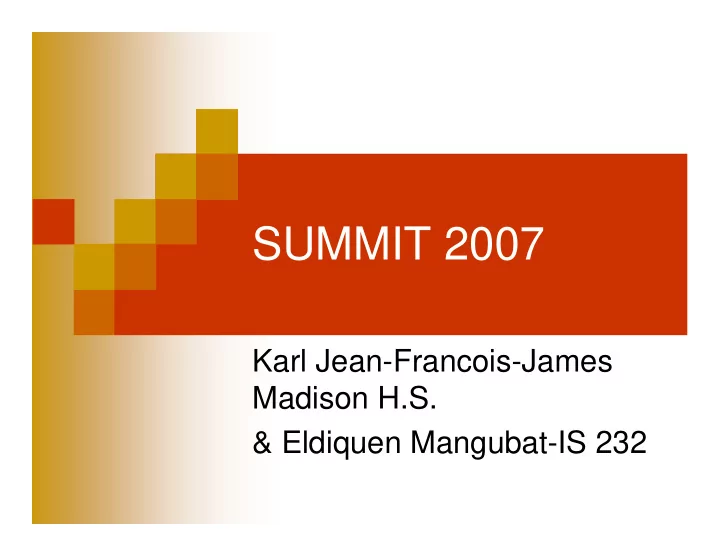

SUMMIT 2007 Karl Jean-Francois-James Madison H.S. & Eldiquen Mangubat-IS 232
Visualization of theDoppler Effect
Purpose This instrument is one of the many that we will build which will help our students visualize scientific concepts that are abstract.
Introduction � Our project aims to make it easier for our middle school and high school students to comprehend how Doppler Effect works. � This concept is an obscure concept to most students to visualize without the aid of machines such as the one we have just finished built.
Introduction Integrating Ultrasonic Sensors,servomotors, and a microcontroller to demonstrate the Doppler Effect
Designing Process Our design is a two-fold design. Program the servomotor to drive the cart forward while transporting an ultrasonic sensor that emits and receives sound pulses.
Design Program the servomotors to drive the cart backward
Hypothesis � Relationship between Vsource and Shifted Frequency When the Source is moving away. � Relationship between Vsource and Shifted Frequency when the source is moving toward the stationary observer.
List of Components � Servomotors � Boe-bot � Basic Stamp � Ultrasonic Sensor � LCD
Major Components
LCD
Calibration of the Servomotors � Insert the tip of Phillips screwdriver into potentiometer access hole. Continue turning � the potentiometer until the motor stops turning.
Centering the Servos The Basic Stamp is programmed � to send to the servos a signal, instructing them to stay still. � We used a screwdriver to adjust them so that they stay still.
Calibration of the Servomotors
Servo Connection Schematics and Wiring Diagram
Duration of a Pulse Width � Pulse width of 850 corresponds to 1.7 ms � Pulse width of 650 corresponds to 1.3 ms � 1.7ms – Servo connected to P1 � 1.3 ms – Servo connected to P0 � 20 ms – Pause duration � 1.6 ms – Code overhead
Determination of the Duration of the length of the servo motor running � --------- ------------------------------ � 24.6 ms – Total � If you want to run the servos for a certain amount of time, you can calculate it like this: � Number of pulses = Time s / 0.0246s = Time / 0.0246 � Lets’ say we want to run the servos for 3 seconds. That’s � Number of pulses = 3 / 0.0246 = 122
How Can We Know How Long the ServoMotor is Working? � In the prograrm below, the EndValue of the FOR…NEXT loop is 122 which can be multiplied by 0.0246 to get 3 seconds � FOR counter = 1 TO 122 � PULSOUT 13, 850 � PULSOUT 12, 650 � PAUSE 20 � NEXT
Program that Controls the Motion of the Servo Motors ' Robotics with the Boe-Bot - ServosP13CcwP12Cw.bs2 ' Run the servo connected to P13 at full speed counterclockwise ' and the servo connected to P12 at full speed clockwise. ' {$STAMP BS2} ' {$PBASIC 2.5} DEBUG "Program Running!" DO PULSOUT 13, 850 PULSOUT 12, 650 PAUSE 20 LOOP
The Ping Ultrasonic Sensor
The Schematic Diagram of the Ping
How Does the Ping Sensor Work? The Ping))) sensor sends a brief chirp with its ultrasonic speaker and measures the echo's return time to its ultrasonic microphone.
Determination of Distance Using the PING)))™ Ultrasonic Sensor � Provides distance measurements between moving or stationary objects. � The time it takes for the echo to return from the target calculates the distance measurement.
Standards � Standard 5 – Technology � Engineering design is an iterative process involving modeling and optimization used to develop technological solutions to problems.
Standards Technological tools, materials, and other � resources should be selected on the basis safety, cost, availability, appropriateness, and environmental impact. � Technological processes change energy, information, and material resources into more useful forms.
New York State Standards � Mathematical analysis, scientific inquiry and engineering design, as appropriate to, pose questions seek answers and develop solutions. � Students will develop an understanding of computer programming and attain some facility in writing computer programs.
Programming Variables D1 VAR Word ' D1 = Initial distance (cm) � D2 VAR Word ' D2 = Final distance (cm) � v VAR Word ' v = Velocity (cm/s) � t VAR Word ' t = Time (s) � fprime VAR Word ‘ fprime = Frequency of Observer (Hz) � counter VAR Word ‘ Counter for the servo � Constants v0 CON 34000 ‘v0 = Velocity of Ultrasonic (cm/s) � f CON 40000 ‘f = Frequency of Ultrasonic (Hz) � CmConstant CON 2260 ‘CmConstant = Distance Constant �
Programming Ultrasonic Sensor Taking Initial Distance Reading � PULSOUT 15, 5 � PULSIN 15, 1, t � PAUSE 2000 � D1 = CmConstant ** t � DEBUG HOME, "Initial Distance Measured: ", DEC3 D1, " cm", CR
Programming Ultrasonic Sensor Taking Final Distance Reading � PULSOUT 15, 5 � PULSIN 15, 1, t � PAUSE 100 � D2 = CmConstant ** t � DEBUG "Final Distance Measured: ",DEC3 D2, " cm ", CR
Programming Calculations for Velocity & fprime � v = (D2-D1)/3 � DEBUG "Velocity: ", DEC3 v, " cm/s ", CR � fprime = f*(v0/(v0-v)) � DEBUG "f': ", DEC5 fprime, " hz "
Programming LCD Display SEROUT 3, 84, [22, 12] � SEROUT 3, 84, [128, “Initial Distance”, DEC3 D1, " cm " ] � PAUSE 2000 � SEROUT 3, 84, [128, “Final Distance”, DEC3 D2, " cm " ] � PAUSE 2000 � SEROUT 3, 84, [128, “Velocity”, DEC3 v, “cm/s” ] � PAUSE 2000 � SEROUT 3, 84, [128, “Frequency”, DEC5 fprime, "hz"] � PAUSE 2000 �
Thanks to � Dr Kapila � Dr Noel
Gratitude � Aschuman � Padmini � Valentin � Daniel
Thanks To � Nathan � Jared � Billy
Thanks Special Thanks to Shing Lik Wong, our mentor.
Recommend
More recommend